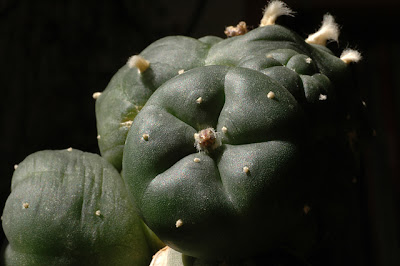Today one of my Lophophora williamsii (SB 854; Starr Co, Tx) plants is celebrating its 3rd anniversary as a scion grafted onto a Trichocereus pachanoi stock. The plant has set 4 offshoots and grown to a width of 7.3 cm (~2.9''), 3 of the offshoots are wider than 4 cm (~1.6'') while the smallest just exceeds 2.5 cm (~1'').
_20070421.jpg)
Grafted Lophophora williamsii (SB 854; Starr Co, Tx)
The plant set 9 flowers last year and has already displayed two flowers this year. The dried fruits resulting from last season’s flowers are clearly visible in the above photo along with the withered remains of the two “fresh” flowers from this week. The photo below was taken a couple of days ago while the flowers were still at their peak.
_20070421.jpg)
Two early Lophophora williamsii flowers
Usually I assist the plant with its self-pollination but this season I will not interfere. I’m doing this to test to which degree the plant will be able to set seed without any help – of course I can’t do anything about the thigmotropic reactions of the stamens or insects taking liberties with the flowers ;-)
A couple of days ago a flower bud also appeared on the largest of the offshoots and it will probably bloom within a week; unfortunately I will not be home to witness it. If all the offshoots begin to flower and the main shoot continues to flower in its usual pace, I’ll soon grow more seeds than I’ll ever need.

Offshoot setting a flower
Since last summer the Trichocereus pachanoi stock has also been allowed to grow an offshoot. Usually I remove these from stock plants in order not to starve the scion, but this one appeared almost at soil level and I decided to let it grow and later graft one of last years Lophophora williamsii (SB 854; Starr Co, Tx) seedlings onto it (these seedlings are the result of self-pollinating the above plant, i.e. technically they are clones of the mother plant). I had planned to do the graft today, but I’ll leave for the Netherlands tomorrow and decided to postpone doing the graft till I’m back.

Trichocereus pachanoi stock with offshoot
I was in doubt whether or not to include the last photo but decided to do it anyway. I’m fascinated by the dreamy image of the flowers backlit by the soft light of the setting sun, filtered through the foliage of a sprawling Bowiea volubilis. My girlfriend finds the picture boring and “too green” – but who is she to trust, she’s not into cacti ;-)

Flowers backlit by the setting sun
For comparison you can check the posts on the same graft written one and two years ago.
Update - April 28, 2007
Fortunately I made it home from the Netherlands in time to experience the pup unfold its first flower. The flower is not as sturdy as those of the main shoot, but what’s to expect from a novice ;-)

Flowering Lophophora williamsii pup
Today I also removed the dried fruits of last season’s flowers and freed the seeds.

9 dried Lophophora williamsii fruits

Close-up of dried Lophophora williamsii fruit
The result of the harvest was approximately 100 seeds.

Home grown Lophophora williamsii seeds
Malpighia 1927 v.30 (added: 11/24/2025)
-
*By:*
Borzi, Antonino,1852-1921.
Penzig, O.1856-1929.
Pirotta, Romualdo,1853-1936.
*Publication Info:*
Messina : g. Capra & co., 1887-89 ; Genova : Tip. di A...
1 month ago



















Wow dude.
ReplyDeleteAmazing blog. going through the archives now.
heaps stoked to find such a good blog on lophophora.
have just started getting into grafting and am posting about my experiences on a blog.
nothing as impressive as some of your grafts though. very cool stuff.
I realy love your blog, great pictures! Greetings, Andreas
ReplyDeletewhat part of the plant has the hallucinogen in it?
ReplyDeleteI assume you are referring to mescaline (3,4,5-trimethoxyphenethylamine) that is present in varying amounts in most of the plant. Allegedly the highest concentrations occur in the photosynthetic tissue.
ReplyDeleteI love ur collection and ur grafts do well. I have a garden of Chiefs as well. I am a Roadman of the native american Church here in Texas. Keep up the good work ;)
ReplyDeleteAdam, I'd love to learn more about your peyote garden. Do you by any chance have some photos you would like to share?
ReplyDelete